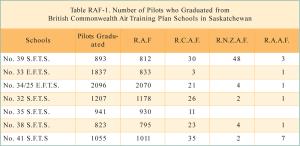
The Royal Air Force has been active in Canada throughout the history of military aviation, though mainly in a supportive or advisory capacity initially. The Royal Flying Corps and the Royal Naval Air Service, forerunners of the Royal Air Force, made administrative and instructional personnel available at training establishments in Canada. Many young Canadians served in these units during World War I and before the establishment of the Royal Canadian Air Force in 1924. As a result of this experience in organization and co-operation, it was logical to consider Canada as the training ground for the British Commonwealth Air Training Plan (BCATP) when it was established in 1939. This agreement was signed by Australia, Canada, the United Kingdom, and New Zealand, on December 17, 1939, and the first schools were opened April 29, 1940. Growth thereafter was rapid, and by the end of 1943 there were 97 schools and 187 ancillary units operating at 231 sites. This number includes 27 RAF schools, seven of which were located in Saskatchewan. The choice of sites for these facilities was often controversial and more often than not politically motivated. However, it was obviously of considerable interest to a local community to be included in the list of successful candidates. The immediate economic benefits breathed new life into sections of the country still suffering from a long period of drought and depression, and in many cases this boost to the local economy resulted in the growth of new industries and services which lasted far beyond the period of wartime activity.
The schools staffed and administered by the RAF were at Swift Current, Caron, Assiniboia, Moose Jaw, North Battleford, Estevan and Weyburn. Swift Current was home to two different schools: No. 32 Elementary Flying Training School (EFTS), which operated from July 1941 to November 26, 1941, when it moved to Bowden, Alberta, and thereafter to No. 39 Service Flying Training School, (SFTS), which was active from December 15, 1941, until March 24, 1944. No. 33 EFTS at Caron was initially operated by the RAF (January 5 to May 25, 1942), and then was joined by a civilian-operated school from Boundary Bay, British Columbia, No. 18 EFTS. The school was disbanded on January 1, 1944. Assiniboia was the site of another of the joint RAF civilian-operated elementary schools. No. 34 EFTS (RAF) was formed on February 11, 1942, and was joined by No. 25 EFTS (RCAF), operated by Central Manitoba Flying Training School Ltd. on July 6, 1942. Training ceased on July 28, 1944. Originally numbered No. 10 SFTS at Tern Hill in Shropshire, England, this school was moved as a unit to Moose Jaw in November 1940 and renumbered No. 32 SFTS; it was finally disbanded on October 17, 1944. As is well known, this school continued under different direction, and is now the home of the Snowbirds, Canada's famous aerobatic team, and of the NATO international flying training school. No. 35 SFTS North Battleford operated from October 4, 1941, to February 25, 1944 - after which it continued as No 13 SFTS (RCAF), relocated from St. Hubert, Quebec. No. 38 SFTS was stationed at Estevan and was in service from April 27 until February 11, 1944. No. 41 SFTS Weyburn also operated during a similar period, January 1, 1942 to January 22, 1944.
The students trained at these schools were predominantly RAF; but as the following numbers indicate, some were from other partners in the plan (see Table RAF-1). Students from EFTS continued their training at SFTS so that these figures do not indicate the total number of pilots produced by the BCATP; nor do they indicate the total involvement of RAF personnel trained at RCAF schools, including Bombing and Gunnery as well as Air Observer schools. Such schools - at Regina, Saskatoon, Mossbank, Dafoe, Prince Albert, Yorkton, and Davidson - trained a total of 24,775 students, of which approximately 4,500 were RAF, 1,500 RNZAF, and 2,500 RAAF. In addition to the obvious importance and success of this program, the impact on society in general should not be overlooked. Cultural influences were noticeable, and the warmth and hospitality of the host communities resulted in lasting friendships and in many cases marriages, which in turn led to resettlement for one or the other of the partners.
Howard Leyton-Brown
Print EntryHOME | BROWSE BY SUBJECT | ENTRY LIST (A-Z) | IMAGE INDEX | CONTRIBUTOR INDEX | ABOUT THE ENCYCLOPEDIA | SPONSORS TERMS OF USE | COPYRIGHT © 2006 CANADIAN PLAINS RESEARCH CENTER, UNIVERSITY OF REGINA | POWERED BY MERCURY CMS |
|||
| This web site was produced with financial assistance provided by Western Economic Diversification Canada and the Government of Saskatchewan. |
|||
 |
 |
 |
 |
| Ce site Web a été conçu grâce à l'aide financière de Diversification de l'économie de l'Ouest Canada et le gouvernement de la Saskatchewan. |
|||